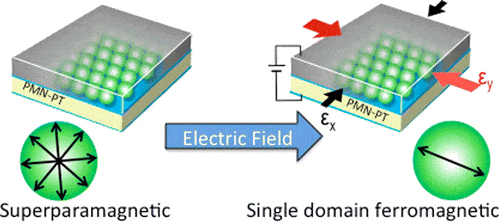
Even though the sound of it is something quite atrocious, superparamagnetism may become a familiar term in the context of nanoscale electronics and devices.
Loosely speaking, superparamagnetism is a size-based phenomenon in which materials that are ferromagnetic on the macroscale — meaning predisposed toward strong magnetization at room temperature, such as iron and nickel — display zero net magnetization at nanoparticle sizes. This phenomenon occurs because, at nanoparticle sizes, the energy required to disturb alignment of the material’s magnetic moment(s) decreases enough that ambient thermal energy is sufficient, and net magnetization gets zeroed out. The temperature required for thermal disruption of magnetization in bulk nickel is over 300 °C, but drops to about room temperature below 50-nm particle size (and continues to drop rapidly with decreasing particle size).
If you’re like me, your beanie is already spinning, but what does this have to do with nanoscale devices?
Much of technology as we know it utilizes natural electromagnetism: when a current runs through a wire, a weak magnetic field is produced. To maximize the magnetic field strength, a typical macroscale electromagnet is made by coiling a conducting wire around a ferromagnetic (usually iron) core. Controlling the electrical current through the wire then allows a very strong magnetic field to be turned on and off and tuned in magnitude.
The problem is, this configuration doesn’t work well at very small sizes primarily due to resistive loss (energy lost as heat). Further, bringing ferromagnetic core materials down to nanoparticle sizes means dealing with superparamagnetic behavior, a significant divergence from the macroscale.
Thus, the push for device miniaturization includes research into new approaches for electrically controlling magnetization on small (especially nano) size scales, at room temperature.
In a recent breakthrough out of UCLA, a research team led by Gregory Carman and Sarah Tolbert succeeded at controlling magnetization of 16-nm superparamagnetic nickel nanocrystals using a clever design in which the nanocrystals were mechanically coupled to a piezoelectric substrate. Electric-field-induced strain on the piezo produced an axis of maximum strain, which in turn created a magnetic easy axis in the Ni nanocrystals (i.e. an axis of preferred alignment of their magnetic moments). This resulted in an increase in the temperature required for (superparamagnetic) thermal disruption of magnetization (from room temperature) to 67 °C. Additionally, the magnetization state sustained after the electric field was removed, and could be controlled via subsequent electric-field induced manipulation of the piezo. In other words, the researchers were able to turn net magnetization on and off, as well as manipulate its magnitude (analogous to, yet markedly distinct from, conventional macroscale electromagnets).
As described at Phys.org:
In a discovery that could lead to big changes in storing digital information and powering motors in small hand-held devices, researchers at UCLA have developed a method for switching tiny magnetic fields on and off with an electric field—a sharp departure from the traditional approach of running a current through a wire.
The researchers, affiliated with the university’s National Science Foundation–funded TANMS (Translational Applications of Nanoscale Multiferroic Systems), developed a composite that can control magneto-electric activity at a scale of about 10 nanometers…
The team used a composite of nickel nanocrystals coupled with a single crystal of piezoelectric material—which can generate power when a small amount of force is applied to it—to control the north–south orientation of the particles as well as their tendency to spin around, which are essential aspects of activating or deactivating a magnetic field.
…
In the Nano Letters abstract, the authors state, “We believe this is the first example of a system where an electric field can be used to switch on and off a permanent magnetic moment.” In the full length paper, the authors describe the potential application of this breakthrough to magnetic memory.
The magnetic properties of nanoparticles are also of key significance in other areas of nanoscale research, including imaging and drug delivery. Expect to see plenty more examples of exploitation and/or circumventing of superparamagnetism and other uniquely size-based phenomena in the decades ahead.
-Posted by Stephanie C
